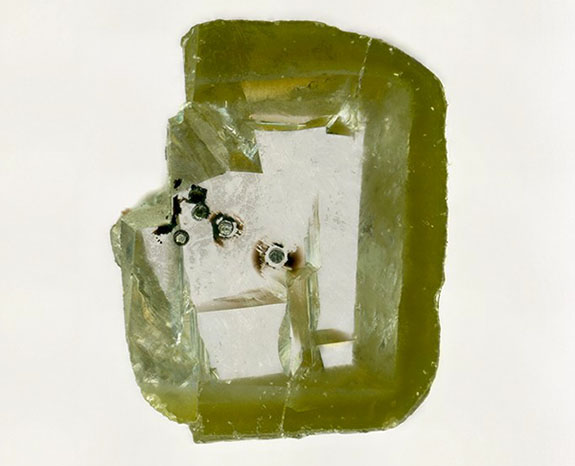An unstable, deep-Earth mineral that shouldn't be able to exist on the surface has been found inside a diamond.
“It’s the strength of the diamond that keeps the inclusions at high pressure,” Oliver Tschauner, a geochemist at the University of Nevada, Las Vegas, told Live Science.
Before the discovery, davemaoite existed theoretically.
Under extreme pressure and heat, it presents as calcium silicate perovskite, but degrades into other minerals when it moves toward the surface and pressure decreases.
The tiny spec of davemaoite was able to make to 400-plus-mile journey to the surface — and stay intact — because it was trapped within a diamond.
As diamonds form hundreds of miles beneath the Earth’s crust, tiny bits of their surrounding environment can be trapped inside. What’s particularly unique about diamonds is that the inclusions will remain under the same pressure as they were during the time they were encapsulated.
Diamonds can be blasted hundreds of miles to the surface during volcanic eruptions. The vertical superhighways that take the diamonds on their journey are called kimberlite pipes.
“Diamond is a remarkable vessel for sampling the geochemistry of the deep mantle,” Steven Jacobsen, a mineral physicist at Northwestern University, told EOS.org in 2018, “because of its ability to seal off trapped inclusions from the reactive environment during ascent, like a tiny indestructible spaceship.”
Named after scientist Ho-kwang ‘Dave’ Mao, davemaoite was approved as a new mineral by the International Mineralogical Association. Mao is famous for his pioneering discoveries in the field of high-pressure geochemistry and geophysics.
Scientists confirmed the presence of davemaoite in the diamond by using a technique known as synchrotron X-ray diffraction. The researchers focused a high-energy beam of X-rays on the inclusions within the diamond and then measured the angle and intensity of the returning light. Those results revealed a distinctive chemical signature of what was inside. The davemaoite inclusions measured just a few micrometers (millionths of a meter) in size.
While most diamonds are formed under intense pressure and heat at a depth of 93 to 124 miles, the diamond encasing the davemaoite material was likely formed 400-plus miles below the surface. The greenish, octahedral-shaped deep-Earth diamond samples studied by Tschauner and his team had been unearthed at the Orapa mine in Botswana.
Scientists believe that davemaoite is one of three main minerals in Earth’s lower mantle and makes up 5% to 7% of the material in the mantle. Davemaoite is believed to be part of the group of minerals that helps manage how heat moves and cycles through the deep Earth.
Credit: Image by Aaron Celestian, Natural History Museum of Los Angeles County.















